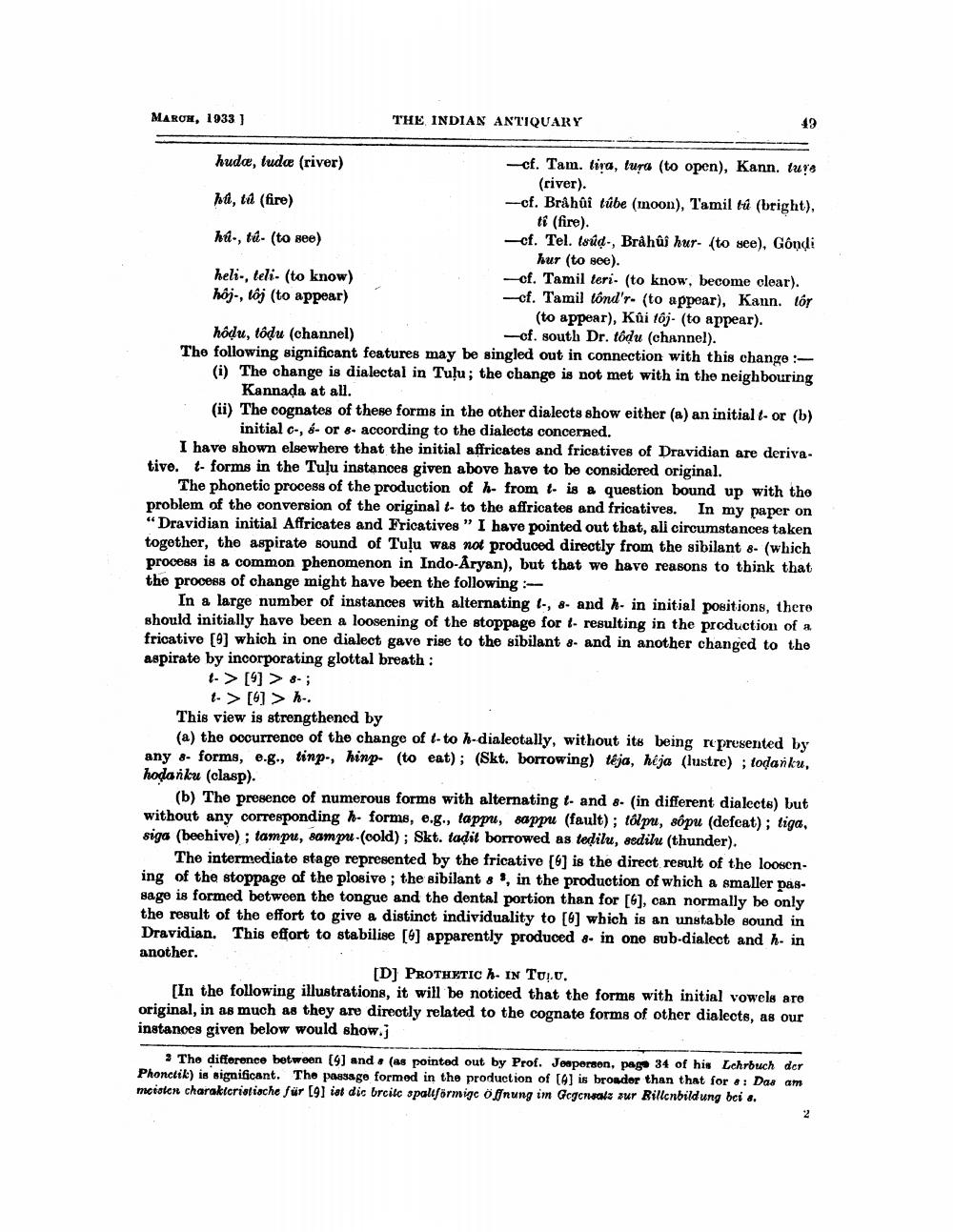________________
MAROH, 1933]
THE INDIAN ANTIQUARY
49
hudæ, tudæ (river)
--cf. Tam. tiya, tura (to open), Kann. ture
(river). ha, tú (fire)
--cf. Bråhùi tûbe (moon), Tamil tú (bright),
ti (fire). hu-, tá - (to see)
-cf. Tel. (súd., Brahûi hur- (to see), Gôndi
hur (to see). heli-, teli. (to know)
--cf. Tamil leri. (to know, become clear). hộj-, lôj (to appear)
--cf. Tamil tónd'r- (to appear), Kann. lor
(to appear), Kûi tôj. (to appear). hôdu, tôdu (channel)
-of. south Dr. tôdu (channel). The following significant features may be singled out in connection with this change :(i) The change is dialectal in Tulu; the change is not met with in the neighbouring
Kannada at all. (ii) The cognates of these forms in the other dialects show either (a) an initial t- or (b)
initial c-, ó- or 8- according to the dialects concerned. I have shown elsewhere that the initial affricates and fricatives of Dravidian are derivative. t. forms in the Tulu instances given above have to be considered original.
The phonetic process of the production of h- from t. is a question bound up with the problem of the conversion of the original t- to the affricates and fricatives. In my paper on "Dravidian initial Affricates and Fricatives " I have pointed out that, all circumstances taken together, the aspirate sound of Tulu was not produced directly from the sibilant 8. (which process is a common phenomenon in Indo-Aryan), but that we have reasons to think that the process of change might have been the following:
In a large number of instances with alternating t., 8. and h-in initial positions, there should initially have been a loosening of the stoppage for t- resulting in the production of a fricative [9] which in one dialect gave rise to the sibilant 8. and in another changed to the aspirate by incorporating glottal breath :
t-> (9] > 8-;
t-> (6]> h-. This view is strengthened by
(a) the occurrence of the change of 1-to h-dialectally, without its being represented by any 8- forms, e.g., tinp., hinp. (to eat); (Skt. borrowing) tēja, héja (lustre) ; todanku, hodanku (clasp).
(b) The presence of numerous forms with alternating t- and 8. (in different dialects) but without any corresponding h- forms, e.g., tappi, cappu (fault); tôlpi, sópu (defeat); tiga, siga (beehive); tampu, sampu (cold); Skt. tadit borrowed as tedilu, sedilu (thunder).
The intermediate stage represented by the fricative (6) is the direct result of the loosening of the stoppage of the plosive; the sibilant s', in the production of which a smaller passage is formed between the tongue and the dental portion than for [6], can normally be only the result of the effort to give a distinct individuality to [0] wbich is an unstable sound in Dravidian. This effort to stabilise [] apparently produced 8. in one sub-dialect and h- in another.
[D] PROTHETIC - IN TUU. [In the following illustrations, it will be noticed that the forms with initial vowels are original, in as much as they are directly related to the cognate forms of other dialects, as our instanoes given below would show.i
The difference between (9) and (as pointed out by Prof. Jesperson, page 34 of his Lchrbuch der Phonetik) is significant. The passage formed in the production of (4) is broader than that for .: Das am mcision charaktcristische für [9] ist dic brcile spaltförmigcoffnung im Gegensatz zur Rillenbildung bei d.




